ALVA SMITH BLANCHARD (1829-1909)

Alva Smith Blanchard was born on December 16, 1829, in the Town of Barre (now Albion), Orleans County, New York. He was the second of twelve children of Willard and Lois Smith Blanchard. Tragically, seven of his siblings either died in childhood or during the Civil War.
Alva’s father, Willard, was a shoemaker, and he kept ledger books for the years 1836 to 1848, in which he noted several instances when his son “Alvah” went to work for various people. The first such notation was in May 1841, when Alva would have been only 11 ½ years old. Willard didn’t note down what kind of work Alva was doing, but he evidently went to work for a man named Sekel Root (spelling may be wrong) over the summer of 1841 from May to September. The next summer Alva worked for Daniel Rite (spelling may be wrong) from April to September, 1842, and then he went back to work, possibly still for Daniel Rite, in October.
Willard made the following entry on December 14, 1846, when Alva would have been two days shy of his 17th birthday: “Alvah Blanchard commenst for Eliger Boat.” This was probably some kind of job, and it’s unclear what “Eliger Boat” refers to – maybe Elijah’s boat? And on August 2, 1847, Willard wrote that: “Alvah Blanchard commenst on the Canall.” That would be the Erie Canal, which runs right through Albion. Alva must have had some sort of job on the Canal. He was not quite 18 years old at the time.
On February 21, 1850, Alva married Amanda Jane Freer, who originally hailed from Ulster County, New York. They were married in the Town of Murray, Orleans County, New York. Alva was 20 and “Jane” – as she was evidently known – was 17, or maybe only 16, depending on which date of her birth is accurate.
The 1850 Federal Census for Barre showed Alva’s occupation as “laborer.”
Alva and Jane’s first child, Kirk Smith Blanchard, was born in Barre on October 6, 1852. Kirk married Sabina S. Darrow and for many years he ran a canning plant and vinegar works in Clarendon and later in Albion.
In the 1855 New York State census for the Town of Murray Alva’s occupation was listed as “farmer.” In 1859 he settled in Clarendon, and the 1860 Federal census for Clarendon noted his occupation as “farmer” as well.
Alva and Amanda’s next three children were all born in Clarendon: Carrie Jane on June 18, 1859, Judd A. on January 7, 1865, and Alva Ward on January 13, 1872. Carrie married Dey E. Wilcox, an optician from Wisconsin. Judd, who was also seen in some records as "George," married Nettie S. Benton. Judd was in the cemetery monument business. And Alva (who went by Ward in his early years) married Lucy Gay Stevens. He started out in automobile sales but ended up selling real estate.
Alva Smith Blanchard had been a member of the Christian Church of Manning, a hamlet in the Town of Clarendon, from about 1869 until his death.
Alva served as collector in Clarendon in 1869. A collector was an official who collected funds or money. No further details are known about this position.
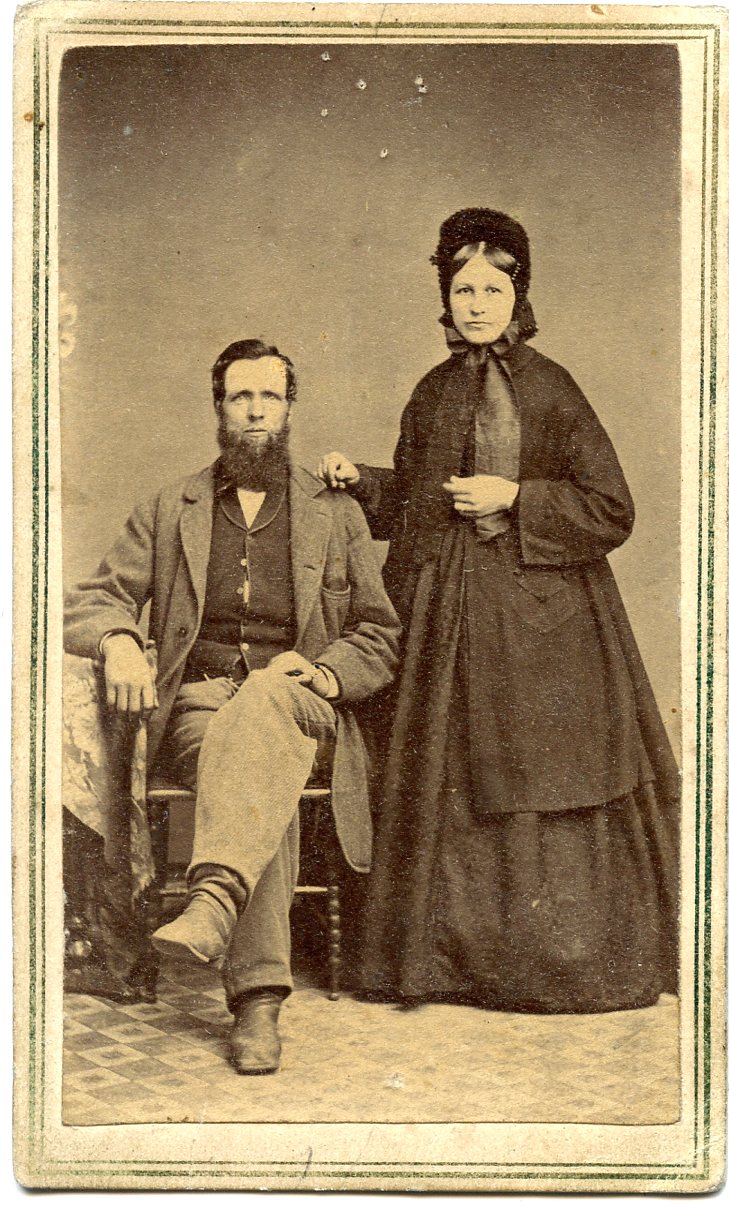 In 1870 information about Alva and his farm showed up on a census form called an Agricultural Schedule. Alva was still living in Clarendon at the time, and the information was gathered on June 10, 1870, by one N. E. Darrow. (That would most likely be Nicholas Eggleston Darrow, who happened to have a daughter, the aforementioned Sabina, who married Alva’s son Kirk and who was therefore Alva’s daughter-in-law). Alva’s holdings included 157 acres of improved land and 8 acres of unimproved woodland. The cash value of his farm was $16,500 and the value of his farm machinery was $800. His livestock included horses, milch cows, “other cattle,” sheep and swine. In addition to wool and butter, he produced the following crops on his farm: winter wheat, Indian corn, oats, barley, peas and beans, Irish potatoes, “orchard products” and hay. The estimated value of all his farm production was $2,296. This undated photo of Alva and Jane may have been taken around this time. In 1870 information about Alva and his farm showed up on a census form called an Agricultural Schedule. Alva was still living in Clarendon at the time, and the information was gathered on June 10, 1870, by one N. E. Darrow. (That would most likely be Nicholas Eggleston Darrow, who happened to have a daughter, the aforementioned Sabina, who married Alva’s son Kirk and who was therefore Alva’s daughter-in-law). Alva’s holdings included 157 acres of improved land and 8 acres of unimproved woodland. The cash value of his farm was $16,500 and the value of his farm machinery was $800. His livestock included horses, milch cows, “other cattle,” sheep and swine. In addition to wool and butter, he produced the following crops on his farm: winter wheat, Indian corn, oats, barley, peas and beans, Irish potatoes, “orchard products” and hay. The estimated value of all his farm production was $2,296. This undated photo of Alva and Jane may have been taken around this time.
Around 1878 Alva went out to Anderson County, Kansas, probably to the town of Colony. Anderson County is in the east central part of the state, and the population of Colony in 1877 was only about 85 residents. Alva had apparently hooked up with a man named J.S. Hawes who was a Hereford cattle breeder. Hawes had started his business in Maine, then moved his herd in 1881 to a 1,200-acre ranch in Colony which he called Mt. Pleasant Stock Farm.
Alva didn’t actually settle permanently in Kansas in 1878. He was probably there just temporarily, getting started in the cattle transport business and maybe looking for a place to live.
In February 1879 he was installed as a W.F.S. officer (Women for Sobriety?) in the Welcome Home Lodge No. 771 of the I.O. of G.T. (Independent Order of Good Templars), a fraternal temperance society for both men and women, in Clarendon.
In March 1879 there was a blurb under “Real Estate Sales” in the Holley Standard newspaper that said: “Alva I. Blanchard to Kirk H. Blanchard, village lot on Madison St., Albion.” If those initials are typos, then this might be the property that Alva’s father, Willard, had on Madison Street.
A brief notice in an October 1879 issue of an Orleans County newspaper said that Alva was “traveling through the state of Kansas and taking a long look at its inviting fields, cities and towns.” Another newspaper account in November 1879 said that “Alva S. Blanchard and family … left with a large excursion seeking new homes in Kansas.”
His oldest son, Kirk, probably did not go with them. His youngest son, Ward, would have been only eight years old in 1880, and it is positively known that he was there. His middle son Judd was there too. Judd would have been 15 at the time. He shows up -- as George -- in the 1880 Federal census for Rich Township, Anderson County, Kansas. And Alva’s daughter, Carrie, who would have been around 21, must have also been out there with the family. In fact, she may even have preceded the rest of her family, because she was married in April 1880 in Iola, Kansas, which is in the next county south of Anderson County.
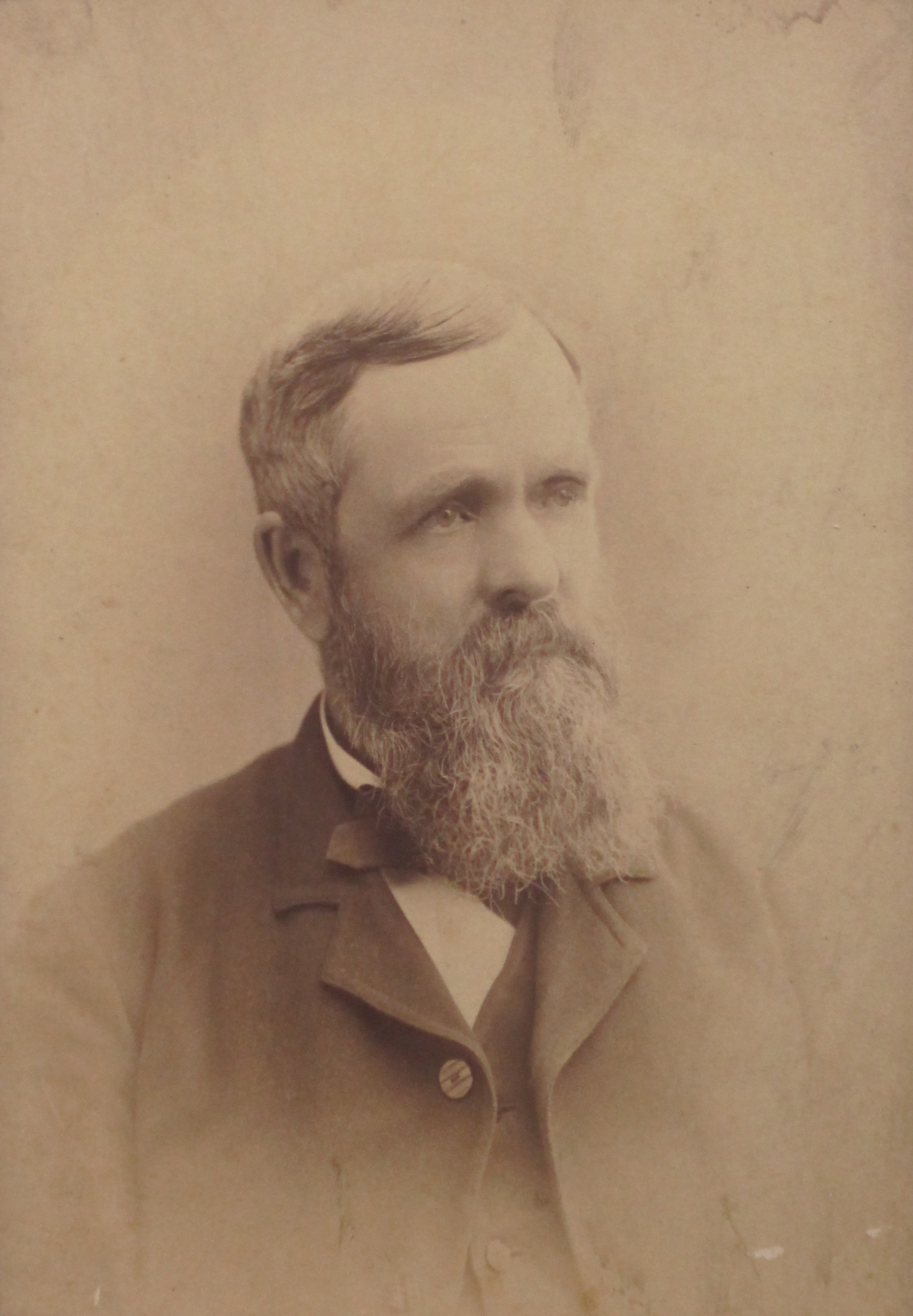
Alva looks about 50-55 years old in this undated photo, so it would fall roughly in this time period.
Through three purchases made between July 1880 and November 1883, Alva bought property from the Kansas City, Lawrence and Southern Railroad that amounted to a little over 200 acres about two miles south of Lone Elm, Anderson County, Kansas, which is about seven miles east of Colony. Lone Elm was also known as Reeve back then.
In late 1881 and early 1882 Alva’s son Kirk and a fellow named Frank F. Turner, presumably a friend of Kirk’s, went out to Kansas on a “visiting tour” that lasted more than forty days. Kirk visited his parents. After their return in late January 1882 the local newspaper back home in Orleans County wrote that the two men “have arrived home looking plump and healthy,” and that Mr. Turner was thinking of making Kansas his future home.
Thanks to several notices in the local Colony, Kansas, newspaper, some of the details of the Blanchards’ life in Kansas in the 1880s have come to light. In January 1884, after having spent three years in Kansas, Alva and his family went back to Orleans County to stay for over a year. An account in the April 10, 1884, Holley Standard newspaper stated that “Alva S. Blanchard occupies the A. Joslyn house for the year to come.” But Alva himself returned to Kansas in March with two carloads of cattle, 100 head in all. In August of that same year he went back to New York, having sold about half of the cattle he brought out in the spring. An Orleans County newspaper from August contained this personal item: “A.S. Blanchard, of Colony, Kansas, is visiting his numerous old friends in this vicinity (i.e., Clarendon).”
In March 1885 Alva returned to Lone Elm with his goods. The rest of his family was due to arrive a week or so later.
In September 1885, Alva and his wife attended a meeting in nearby Iola, Kansas, of an organization called the Society of Orleans County, New York. This was a group of former residents of Orleans County now living in Anderson and Allen Counties, Kansas, who had gotten together for the first time in 1884. According to several different accounts in the Iola Register, this organization was known by at least three other names: the Allen and Anderson County Association, the Orleans County Association and the Orleans County Settlers' Association. In 1885 the membership of the Society numbered 56, and 32 were present at this second reunion. Alva was elected president of the Society for the following year. At the third reunion in 1886, Alva's wife, Jane, was elected vice-president of the association.
Then on September 16, 1887, the group held its fourth annual reunion at A.S. Blanchard’s residence in Lone Elm Township. The Colony Free Press reported that the usual jolly time was had. The attendance was larger than ever before, with 50 persons being present besides invited guests.
Coincidentally, also in September 1887, the Colony newspaper reported that Alva had traded his farm in Lone Elm for a 70-acre farm 13 miles south of Albion, New York, and he and his family were scheduled to move back in a month or six weeks. An article about this move mentioned that when the Blanchards came to Lone Elm, their farm was nothing but raw prairie. In October they sold all three of their lots for $5,000 to Abraham L. Salisbury, a family friend, oddly enough, from back home in Orleans County, New York.
When the family was preparing to leave Kansas, Alva held an auction in October 1887 to sell his farm animals, machinery and other things. The ad in the Colony newspaper said his farm was located "2 miles south of Reeve and 7 miles southeast of Colony."
The Blanchards didn’t actually move back to Albion until February 1888, however. There was this odd account in the February 16, 1888, Colony Free Press: "We hear that since A.S. Blanchard and family moved back to New York they are much dissatisfied, and wish they had not removed from Kansas. Such is the testimony of nine-tenths of the people who leave Kansas for other States. We hope Mr. B. and family will come back." (They didn't.)
 It has been pretty firmly established that after the Blanchards returned to Orleans County, they occupied this house south of Clarendon on what is now called Munger Road (pictured on the left in a 1979 photo). Alva evidently didn't own the building (or the farm), because no deed of sale to him has been found. Instead, he was likely either renting the property from A.L. Salisbury or just living there as part of the swap deal he had made with A.L. Salisbury. After Alva and Jane had moved out of this house, and after Alva had died in April 1909, the property was sold in December 1909 by Mary J. Salisbury (A.L. Salisbury's widow) to a man named Adelbert E. Wetherbee, who lived there for at least five more years. It has been pretty firmly established that after the Blanchards returned to Orleans County, they occupied this house south of Clarendon on what is now called Munger Road (pictured on the left in a 1979 photo). Alva evidently didn't own the building (or the farm), because no deed of sale to him has been found. Instead, he was likely either renting the property from A.L. Salisbury or just living there as part of the swap deal he had made with A.L. Salisbury. After Alva and Jane had moved out of this house, and after Alva had died in April 1909, the property was sold in December 1909 by Mary J. Salisbury (A.L. Salisbury's widow) to a man named Adelbert E. Wetherbee, who lived there for at least five more years.
Alva spent the next twenty years of his life on his farm south of Holley (Clarendon, Honest Hill). He was a member of the I.O.O.F. (Odd Fellows) in Holley and had joined that organization back in May 1875.
Here's a photo of the Alva Smith Blanchard family taken probably around 1890-1895. He and Amanda Jane are seated, and, from left to right, the children are Carrie, Ward, Kirk and Judd.
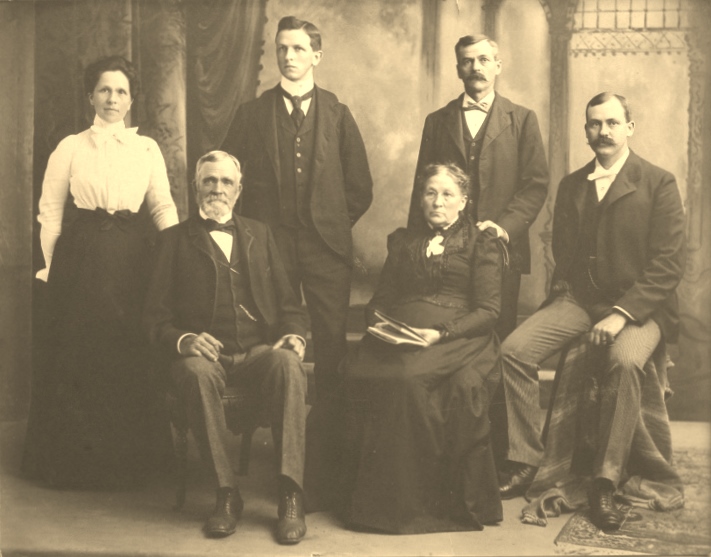 In April 1891 Alva had apparently run for the office of Supervisor in Clarendon on the Prohibition Party ticket. He lost the race by quite a large margin. His membership in the Prohibition Party makes you wonder if he wasn’t influenced to join that particular party because of his father’s intemperance. In April 1891 Alva had apparently run for the office of Supervisor in Clarendon on the Prohibition Party ticket. He lost the race by quite a large margin. His membership in the Prohibition Party makes you wonder if he wasn’t influenced to join that particular party because of his father’s intemperance.
In March 1895 Alva was the sole Prohibition Party nominee for the office of Assessor in the Town of Clarendon. In that same month he was appointed pathmaster for District 33 of the Town of Clarendon. Pathmasters, with the help of their neighbors, were responsible for the maintenance of designated stretches of roads.
Alva kept a diary for about a year between March 1895 and March 1896. The diary has been handed down in the family. This little book provides a wonderful snapshot of the Blanchards’ life for that one year, and it’s probably a pretty good representation of how Alva spent the other twenty years on his farm between the time the family moved back from Kansas and his death. Alva was 65 years old when he started the diary. He didn’t mention the Assessor’s job in his diary, so he most likely didn’t win that election.
The first thing you notice in the diary is that Alva’s literacy is not 100%. He obviously knew how to write, but his knowledge of grammar was a little lacking and his spelling was just phonetic in many places. For example, here’s the entry from April 21, 1895.
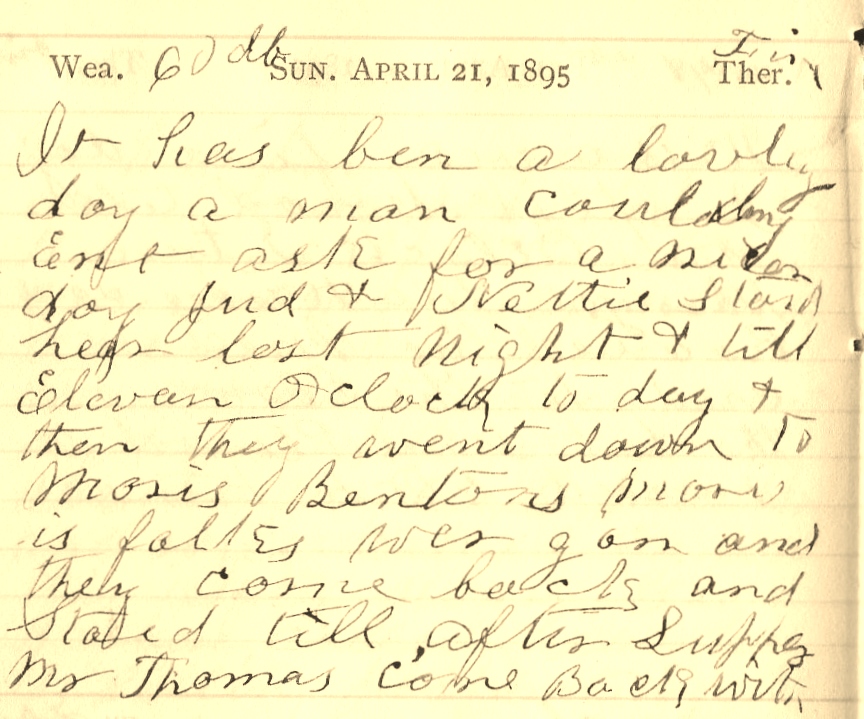
It reads: “It has ben a lovley day. A man could Ent ask for a nicer day. Jud & Nettie Staid hear last night & till Elevan Oclock to day & then they went down to Moris Bentons. Moris is folks wer gon and they come back and Staid till after Supper. Mr Thomas come Back with.”
Summing up his workday, he would write things like “I choard around this four noon.” He wrote how he talked and he spelled words the way they sounded.
Understandably, activities around the farm dominated Alva’s life and kept him busy from dawn to dusk. He kept animals: cows, horses, sheep, chickens, pigs, turkeys. So he had to haul manure a lot and he gathered eggs every day and occasionally sold them and butter that his wife, Jane, had churned. He plowed, rolled, and dragged his fields for his crops. He grew corn, oats, hay, timothy and other crops for the animals. He planted vegetables: peas, beans, sweet corn, potatoes, carrots, celery, pumpkins, etc. He grew grapes too. He butchered hogs to make sausage and smoked hams, he sold lamb, and he killed a turkey for a holiday meal. He cut wood in a nearby swamp that was on his property. He hauled the wood in, cut it up and split it. He never worked on Sundays.
They went to Holley to buy other groceries and clothes. Jane – Alva always referred to her as “Ma” in the diary – washed clothes on Mondays and “irned” on later days in the week, mostly Tuesdays. He occasionally went to what he called “Aliance meetings,” first on Saturday evenings and then on Tuesday evenings, after they changed their meeting date in June 1895. These were most likely the meetings of the Odd Fellows Lodge in Holley, to which he belonged. He or a family member would go “to the village” (presumably to Clarendon) to get the mail.
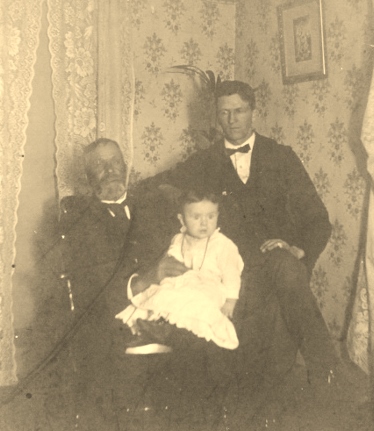 Here's a photo that was taken around 1900 of Alva, his son Ward, and his grandson Yorke. Here's a photo that was taken around 1900 of Alva, his son Ward, and his grandson Yorke.
On February 21, 1900, Alva and Jane celebrated their fiftieth wedding anniversary at their home in Clarendon in the company of many neighbors, relatives and friends. The following observations are extracted from a newspaper article about the event that appeared a few days later. Alva and Jane apparently had to be talked into properly honoring the occasion by their four children. Guests arrived to find the yard around their commodious dwelling filled with carriages. Before and after the supper meal there were speeches and “singing, declamations and other enjoyable entertainments.” The couple received numerous presents, both ornamental and useful, including some from friends in Kansas.
About a year later Jane died on February 6, 1901, in Clarendon. She was 68. She is buried in the Mt. Albion Cemetery.
In these undated photos, Alva looks to be about 70-75 years old.
 
Alva remarried on April 22, 1903, to Carrie E. Cushing, a spinster from Niagara County, New York, who was thirty years his junior.
There is the following entry for Alva in the 1903 Directory of Orleans County under the heading “Town of Clarendon:” “Blanchard, Alvah S., (Honest Hill), r 71, 35 sheep, beans 10, farmer 68.” The “r 71” indicates where his residence was on a map in the back of the directory, which pinpoints it very nicely. The rest of the entry signifies that he had 35 sheep, that he had 10 acres under cultivation for beans, and that he probably farmed 68 other acres.
Alva was one of three candidates nominated by the Prohibition Party for the March 10, 1903, election to office of Assessor in the Town of Clarendon. The outcome of that election is unknown. And in November 1905 he ran for Assessor in Clarendon again, but he and another Prohibition Party candidate got the fewest votes – 20 each. The Republicans won all town offices but one in that election.
Alva suffered a “stroke of paralysis” on April 21, 1909. He had recently moved from his farm to a place called the Hennesy house just south of Holley. He didn’t regain consciousness and died on the 22nd. The cause of death given was cerebral hemorrhage. He was 79. He is buried in the Mt. Albion Cemetery. The following words from his obituary appeared in the April 29, 1909, Holley Standard: “Mr. Blanchard has retained until the very close of his nearly four score years of life, a marvelous possession of mental and physical activity and energy, a vigor of mind and body which might well be envied by many younger men. In personality he was genial, cheerful and obliging in a marked degree; quick to see a need and ever ready to bestow a favor even though it cost personal inconvenience. A pleasant companion to old and young; one whose social tendencies led to warm friendships and whose home was most hospitable to the home coming of the children and grandchildren, and where friends were ever made welcome.”
After Alva’s death, his widow Carrie continued to live in Holley. Perhaps she had been influenced by Alva’s membership in the Prohibition Party earlier, because around 1925 she was a member of the Holley W.C.T.U. (Women’s Christian Temperance Union). In October 1937 she moved to the I.O.O.F. home in Lockport, New York. She died there at age 79 on May 2, 1939, of arteriosclerosis and myocarditis. She is also buried in the Mt. Albion Cemetery.
The Alva S. Blanchard family plot monument and the grave markers for him and Amanda Jane and Carrie in the Mt. Albion Cemetery.
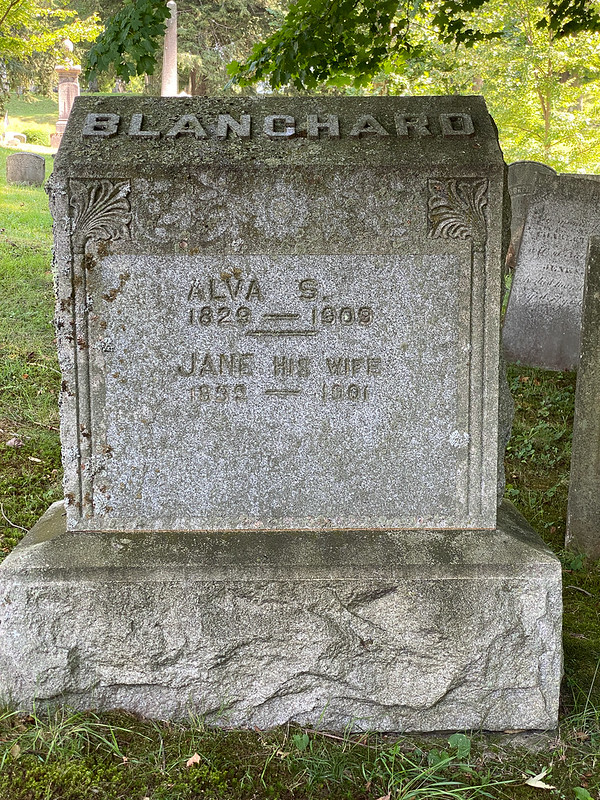
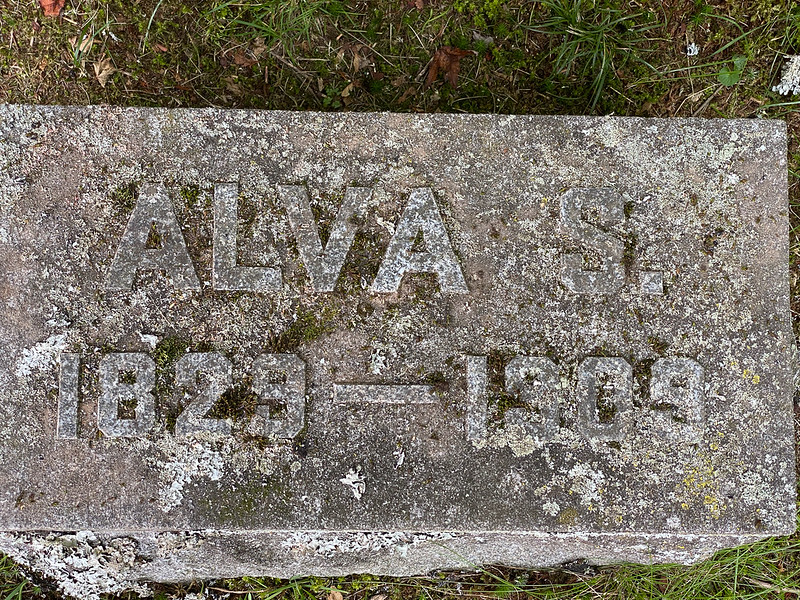
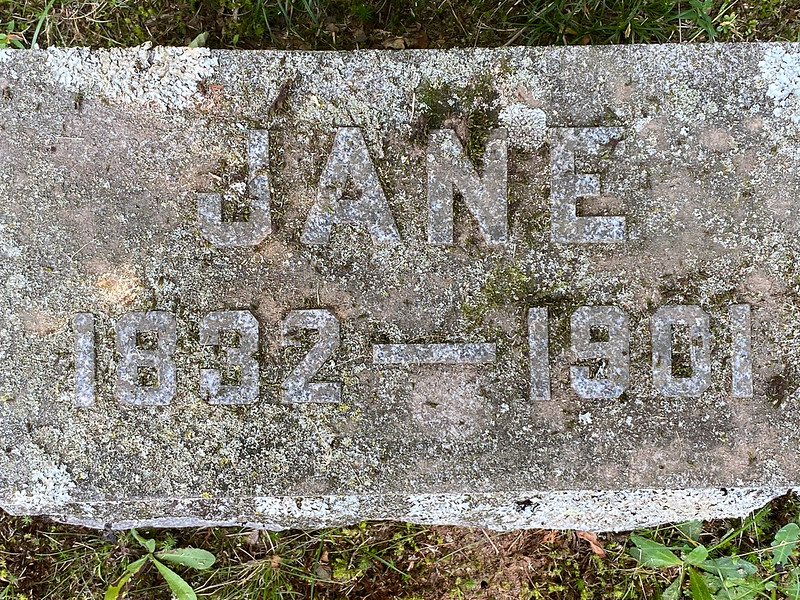 
20211026
|

 In 1870 information about Alva and his farm showed up on a census form called an Agricultural Schedule. Alva was still living in Clarendon at the time, and the information was gathered on June 10, 1870, by one N. E. Darrow. (That would most likely be Nicholas Eggleston Darrow, who happened to have a daughter, the aforementioned Sabina, who married Alva’s son Kirk and who was therefore Alva’s daughter-in-law). Alva’s holdings included 157 acres of improved land and 8 acres of unimproved woodland. The cash value of his farm was $16,500 and the value of his farm machinery was $800. His livestock included horses, milch cows, “other cattle,” sheep and swine. In addition to wool and butter, he produced the following crops on his farm: winter wheat, Indian corn, oats, barley, peas and beans, Irish potatoes, “orchard products” and hay. The estimated value of all his farm production was $2,296. This undated photo of Alva and Jane may have been taken around this time.
In 1870 information about Alva and his farm showed up on a census form called an Agricultural Schedule. Alva was still living in Clarendon at the time, and the information was gathered on June 10, 1870, by one N. E. Darrow. (That would most likely be Nicholas Eggleston Darrow, who happened to have a daughter, the aforementioned Sabina, who married Alva’s son Kirk and who was therefore Alva’s daughter-in-law). Alva’s holdings included 157 acres of improved land and 8 acres of unimproved woodland. The cash value of his farm was $16,500 and the value of his farm machinery was $800. His livestock included horses, milch cows, “other cattle,” sheep and swine. In addition to wool and butter, he produced the following crops on his farm: winter wheat, Indian corn, oats, barley, peas and beans, Irish potatoes, “orchard products” and hay. The estimated value of all his farm production was $2,296. This undated photo of Alva and Jane may have been taken around this time.
 It has been pretty firmly established that after the Blanchards returned to Orleans County, they occupied this house south of Clarendon on what is now called Munger Road (pictured on the left in a 1979 photo). Alva evidently didn't own the building (or the farm), because no deed of sale to him has been found. Instead, he was likely either renting the property from A.L. Salisbury or just living there as part of the swap deal he had made with A.L. Salisbury. After Alva and Jane had moved out of this house, and after Alva had died in April 1909, the property was sold in December 1909 by Mary J. Salisbury (A.L. Salisbury's widow) to a man named Adelbert E. Wetherbee, who lived there for at least five more years.
It has been pretty firmly established that after the Blanchards returned to Orleans County, they occupied this house south of Clarendon on what is now called Munger Road (pictured on the left in a 1979 photo). Alva evidently didn't own the building (or the farm), because no deed of sale to him has been found. Instead, he was likely either renting the property from A.L. Salisbury or just living there as part of the swap deal he had made with A.L. Salisbury. After Alva and Jane had moved out of this house, and after Alva had died in April 1909, the property was sold in December 1909 by Mary J. Salisbury (A.L. Salisbury's widow) to a man named Adelbert E. Wetherbee, who lived there for at least five more years.  In April 1891 Alva had apparently run for the office of Supervisor in Clarendon on the Prohibition Party ticket. He lost the race by quite a large margin. His membership in the Prohibition Party makes you wonder if he wasn’t influenced to join that particular party because of his father’s intemperance.
In April 1891 Alva had apparently run for the office of Supervisor in Clarendon on the Prohibition Party ticket. He lost the race by quite a large margin. His membership in the Prohibition Party makes you wonder if he wasn’t influenced to join that particular party because of his father’s intemperance.
 Here's a photo that was taken around 1900 of Alva, his son Ward, and his grandson Yorke.
Here's a photo that was taken around 1900 of Alva, his son Ward, and his grandson Yorke.




